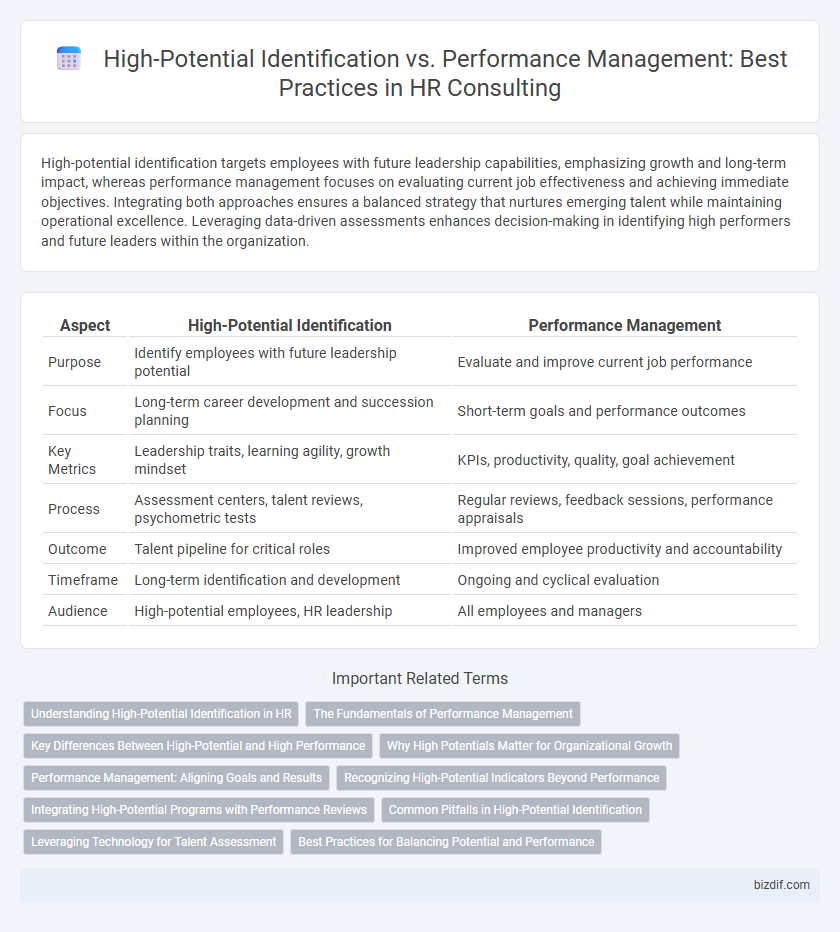High-potential identification targets employees with future leadership capabilities, emphasizing growth and long-term impact, whereas performance management focuses on evaluating current job effectiveness and achieving immediate objectives. Integrating both approaches ensures a balanced strategy that nurtures emerging talent while maintaining operational excellence. Leveraging data-driven assessments enhances decision-making in identifying high performers and future leaders within the organization.
Table of Comparison
| Aspect | High-Potential Identification | Performance Management |
|---|---|---|
| Purpose | Identify employees with future leadership potential | Evaluate and improve current job performance |
| Focus | Long-term career development and succession planning | Short-term goals and performance outcomes |
| Key Metrics | Leadership traits, learning agility, growth mindset | KPIs, productivity, quality, goal achievement |
| Process | Assessment centers, talent reviews, psychometric tests | Regular reviews, feedback sessions, performance appraisals |
| Outcome | Talent pipeline for critical roles | Improved employee productivity and accountability |
| Timeframe | Long-term identification and development | Ongoing and cyclical evaluation |
| Audience | High-potential employees, HR leadership | All employees and managers |
Understanding High-Potential Identification in HR
High-Potential Identification in HR focuses on recognizing employees who demonstrate the ability, aspiration, and organizational commitment to assume critical leadership roles in the future. Unlike Performance Management, which evaluates current job achievements and goal attainment, high-potential identification assesses qualities such as learning agility, adaptability, and strategic thinking. Effective high-potential identification leverages data analytics, psychometric assessments, and managerial input to build a pipeline of future leaders essential for organizational growth and succession planning.
The Fundamentals of Performance Management
Performance management revolves around setting clear objectives, continuous feedback, and regular performance appraisals to enhance employee productivity and align goals with organizational strategy. High-potential identification focuses on recognizing employees with the capability for future leadership roles, while performance management ensures ongoing development and accountability for current roles. Establishing a structured performance management system is fundamental to accurately measure contributions and foster growth within the workforce.
Key Differences Between High-Potential and High Performance
High-potential identification focuses on recognizing employees with the capacity for significant future growth and leadership, while performance management evaluates current job effectiveness and goal achievement. Key differences include the assessment criteria, with high-potential emphasizing adaptability, learning agility, and leadership traits, versus high performance which measures consistent delivery, productivity, and results. Organizations leveraging both strategies can better align talent development with business objectives, ensuring a pipeline of future leaders alongside maximizing current workforce efficiency.
Why High Potentials Matter for Organizational Growth
High-potential identification targets employees with the capability to assume leadership roles and drive strategic initiatives essential for long-term organizational growth. Unlike performance management, which evaluates current job effectiveness, high-potential programs focus on forecasting future contributions and developing critical leadership skills. Investing in high-potential talent accelerates innovation, succession planning, and competitive advantage in dynamic business environments.
Performance Management: Aligning Goals and Results
Performance management in HR consulting emphasizes aligning individual and organizational goals to drive measurable results and enhance productivity. Effective performance management systems integrate continuous feedback, goal-setting frameworks such as OKRs or SMART goals, and data-driven evaluations to optimize employee contribution. Aligning goals with strategic business objectives ensures accountability, improves employee engagement, and supports talent development critical for sustained organizational success.
Recognizing High-Potential Indicators Beyond Performance
High-potential identification in HR consulting focuses on recognizing key indicators such as learning agility, leadership behaviors, and emotional intelligence that extend beyond traditional performance metrics. Effective talent strategies prioritize these attributes to predict future success and drive organizational growth. Incorporating psychometric assessments and continuous feedback mechanisms enhances the accuracy of spotting employees with long-term potential.
Integrating High-Potential Programs with Performance Reviews
Integrating high-potential identification programs with performance management systems enhances employee development by aligning talent assessment with measurable outcomes. Utilizing data from performance reviews to inform high-potential selections ensures a comprehensive evaluation of individual capabilities and growth trajectories. This integrated approach supports targeted succession planning and maximizes organizational agility by fostering a pipeline of future leaders.
Common Pitfalls in High-Potential Identification
Common pitfalls in high-potential identification include reliance on subjective evaluations, leading to biased talent assessments and overlooking diverse capabilities. Overemphasis on current performance metrics may result in neglecting future growth potential and leadership qualities. Inaccurate identification hampers succession planning and stunts organizational development by failing to cultivate truly high-impact employees.
Leveraging Technology for Talent Assessment
Leveraging technology in high-potential identification enhances predictive accuracy through AI-driven analytics and psychometric assessments, enabling HR consultants to pinpoint future leaders beyond current performance metrics. Advanced talent assessment platforms integrate real-time data and behavioral insights, optimizing succession planning by identifying employees with growth potential rather than solely those with high performance ratings. This data-centric approach transforms traditional performance management systems into dynamic tools for strategic talent development and workforce agility.
Best Practices for Balancing Potential and Performance
High-potential identification requires data-driven assessments and behavioral metrics to predict future leadership capabilities, contrasting with performance management's focus on current job results and goal attainment. Best practices for balancing potential and performance emphasize integrating continuous feedback systems and talent analytics to align development plans with both immediate contributions and long-term growth trajectories. Leveraging calibrated talent reviews and competency frameworks ensures equitable recognition of employees who deliver consistent results while demonstrating scalable leadership potential.
High-Potential Identification vs Performance Management Infographic

 bizdif.com
bizdif.com